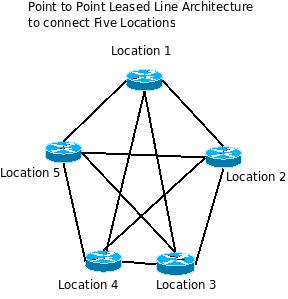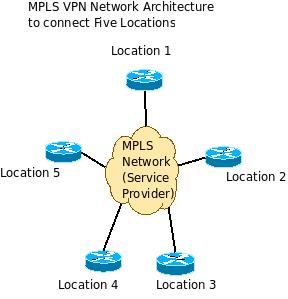Advantages of MPLS VPN Network over Point to Point Leased Lines for WAN Connectivity
In this article, we discuss about two important forms of Wide Area Network Connectivity – MPLS VPN Network and Point to Point Leased Lines. We also see how or why MPLS VPN networks have started to gain more popularity for private wide area network connectivity for medium and large organizations having multiple branches.
When you have multiple branches across a state or a country, you would definitely be wanting to connect all these branches together to facilitate data transfer/ access between them in order to accelerate the speed of business transactions. There are various options to be considered for creating such Wide Area Networks (WAN) like,
Point to Point Leased Lines
MPLS VPN Network Connectivity
Internet Leased Lines with Site-to-Site VPN (Virtual Private Network)
Broadband / VPN over Broadband
Dial-up/ CDMA/ 3G Connectivity /4G Connectivity for small branches
Satellite (VSAT) Connectivity for remote locations
Of these, let us focus on the first two modes of connectivity in this article – Point to Point Leased Lines and MPLS VPN Network connections.


As shown in the first diagram, a point to point Leased Line is formed by connecting every site to every other site using leased lines provided by the service provider network (Or in very large organizations, their own network). This is a private network and is used primarily for site-to-site communications. So for an organization having branches in five locations, four links need to connect each location to all other locations to complete the leased line network. For ‘n’ locations, the number of links required in each location would be ‘n-1’.
An MPLS Network is formed by connecting each location with a single link (as shown in the second diagram) to a service provider MPLS network. An MPLS network stands for Multi-Protocol Label Switching and any packet coming to the Label edge routers (from individual locations – source, to the service provider MPLS network) are encapsulated with an MPLS label which is used to identify it and route it through the MPLS network. This label is discarded when the packet comes out of the MPLS network back to individual locations – destination.
In both the above cases, a wide variety of physical hardware is used to carry the information including fiber, copper circuits, wireless connectivity, satellite connectivity etc. The MPLS core service provider network also use high-capacity MPLS routers in addition to the MPLS edge routers which send and receive data from the routers located in the individual locations.
Let us now look at the Factors which have enabled MPLS VPN Networks to become more favorable for organizations that want to inter-connect their various branches when compared to Point to Point Leased Lines.
Traffic Engineering: Since the MPLS packets are being added at the MPLS Edge routers, it is possible to set the path that the traffic will have to take through the network. More specifically, each class of traffic (like data, voice, video etc) can be set individual performance characteristics.
Quality of Service: Since MPLS network enables traffic engineering, it is possible to send (for example) – data traffic over a lower priority path and real-time delay sensitive voice/ video packets over a high priority/ lesser used/ shorter path. This enables network convergence (The Wide Area Network becomes more suitable for introduction of new services like voice, video, multi-cast traffic, hosting etc).
Network Redundancy: An MPLS core network is generally designed and built to overcome individual hardware (router) faults or line disconnection. In such cases, the data is re-routed through the next optimum path with a fail-over time of 50 ms or lesser. Even the last mile connections can be backed up using CDMA wireless back up etc, depending upon the options with the service provider.
Easy and Cost effective Expansion: For organizations that are having a lot of branches or expanding with new branches, MPLS network would be very cost-effective as each branch needs one MPLS link while each branch would need n-1 links for point to point Leased Lines (n being the total number of branches). MPLS makes it easy for instantaneous addition and deletion of sites.
Protocol Independent forwarding: MPLS networks can carry any type of packets – be it IP, frame relay or ATM using the same infrastructure. This is because, what ever type of packets comes in, MPLS labels would be attached to it for transmitting them over the MPLS network and these labels are protocol independent.
Connection oriented network: MPLS is a connection-oriented network unlike connection less networks like IP. So, it is more reliable.
Service Level Agreement (SLA): Service Providers generally provide an SLA – Service Level Agreement for MPLS networks with a guarantee of very minimum downtime during the contract period (usually one year or its multiples). This is possible because an MPLS network can be pro-actively monitored and maintained. It is possible to analyze the circuit performance continuously and provide immediate fault rectification and support.
Bandwidth Allocation: MPLS networks allow for dynamic bandwidth allocation and hence can be used to provide bandwidth on demand (for a specific period etc) to customers. Further, rate limiting and other bandwidth management parameters allow a certain bandwidth to be dedicated for mission critical applications.
Security: Service providers take full responsibility for the security of information that is sent over an MPLS network. Service providers also create IP tunnels throughout the network without the need for any encryption from user-end.
International MPLS: There are options with service providers to connect individual locations across different countries using MPLS by sharing and inter-connecting their respective MPLS networks.
Lesser Hops: With an MPLS network, there are lesser number of hops between the various network points resulting in improved response times and application performance.
excITingIP.com
You could also subscribe with your email address in the box titled “Get email updates when new articles are published” to receive updates via email when new articles are published in this site.
what I was looking for. Many thanks
What are disadvantage of wireless leased line connection